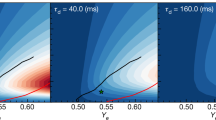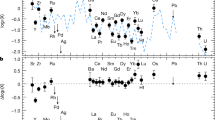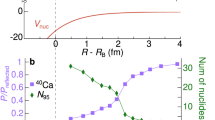Abstract
THE p-elements, those rich in protons, are less abundant than the s or r-elements by factors between 10−3 and 10−4, and are usually bypassed in a slow or fast neutron capturing chain. It has been suggested that they are produced either by (p, γ) or (γ, n) reactions1. Formation by (p, γ) reactions in the envelopes of supernovae, however, would be limited by the short duration of the phenomena2. Other suggestions by Ito3 and Malkiel4 are also inadequate. The smoothness of the abundance distribution of p-elements5,6, however, suggests that they might have been synthesized in one physical environment, and recently there have been attempts to explain the abundances by positron capture in s-elements7 or by spallation processes8. This article is a preliminary report of an investigation of the abundance distribution of p-elements formed in a single event—the fission of highly excited nuclei in supernovae.
This is a preview of subscription content, access via your institution
Access options
Subscribe to this journal
Receive 51 print issues and online access
$199.00 per year
only $3.90 per issue
Buy this article
- Purchase on Springer Link
- Instant access to full article PDF
Prices may be subject to local taxes which are calculated during checkout
Similar content being viewed by others
References
Burbidge, E. M., Burbidge, G. R., Fowler, W. A., and Hoyle, F., Rev. Mod. Phys. J., 29, 547 (1957).
Duorah, H. L., Ind. Pure Appl. J. Phys., 5, 11 (1967).
Ito, K., Prog. Theor. J. Phys., 26, 990 (1961).
Malkiel, G. S., Sov. Astron., 7, 207 (1963).
Suess, H. E., and Urey, H. C., Rev. Mod. Phys., 28, 53 (1956).
Cameron, A. G. W., in Origin and Distribution of the Elements (edit. by Ahrens, C.), 125 (Pergamon Press, London, 1967).
Reeves, H., and Stewart, P., Astrophys. J., 141, 1432 (1965).
Audouze, J., Astron. Astrophys., 8, 436 (1970).
Lefort, M., Nuclear Chemistry, 8 (Van Nostrand Co. Ltd., London, 1968).
Wahl, A. C., Ferguson, R. L., Nethaway, D. R., Troutner, D. L., and Wolfsberg, K., Phys. Rev., 126, 1112 (1962).
Macklin, R. L., Astrophys. J., 162, 353 (1970).
Mattauch, J. H. E., Thiele, W., and Wapstra, A. H., Nucl. Phys., 67, 1 (1965).
Hoyle, F., and Fowler, W. A., Astrophys. J., 132, 565 (1960).
Author information
Authors and Affiliations
Rights and permissions
About this article
Cite this article
DUORAH, H. Production of Proton-rich Nuclei. Nature 232, 247–248 (1971). https://doi.org/10.1038/232247a0
Received:
Issue Date:
DOI: https://doi.org/10.1038/232247a0
Comments
By submitting a comment you agree to abide by our Terms and Community Guidelines. If you find something abusive or that does not comply with our terms or guidelines please flag it as inappropriate.



